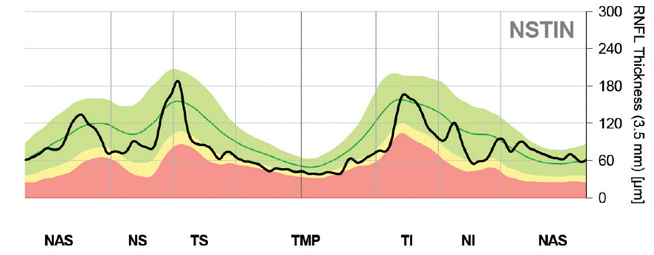 |
|
RNFL thinning (seen here in a glaucoma patient), when found in diabetes patients, may signify a higher risk of peripheral neuropathy. Photo: Ryan Schott, OD. Click image to enlarge. |
Diabetic peripheral neuropathy (DPN) is a common diabetic microvascular complication among those with diabetes. Researchers of a recent study investigated possible associations between retinal nerve fiber layer (RNFL) thickness and DPN. The study also investigated the cross-sectional area of lower limb nerves.
A total of 140 patients with type 2 diabetes were enrolled, 51 with DPN (“DPN group”) and 89 without (“NDPN group”). OCT was used to measure the RNFL thickness. Patients with DPN had a reduced RNFL thickness, prompting the researchers to suggest this measure can be used as a diagnostic indicator of peripheral neuropathy.
The RNFL thicknesses in the DPN group were lower than that in the NDPN group in the overall average 102.05µm vs. 106.94µm), superior quadrant (119.84µm vs. 135.14µm) and inferior quadrant (129.95µm140.98µm). There were no significant differences in temporal quadrant or nasal quadrant RNFL thickness between the NDPN and DPN groups.
Previous research by the same investigators used OCT to measure RNFL thickness in the optic disc area and found that it was related to DPN and can be used as a diagnostic method. “DPN has a huge impact on the life of patients and brings a heavy burden to society. Early identification and treatment of DPN can relieve symptoms, reduce sequelae and improve the quality of patients’ life,” the authors explained in their paper.”
Chen W, Wu X, Li S, et al. Optical coherence tomography of the retina combined with color Doppler ultrasound of the tibial nerve in the diagnosis of diabetic peripheral neuropathy. Front Endocrinol. October 21, 2022. [Epub ahead of print]. |

